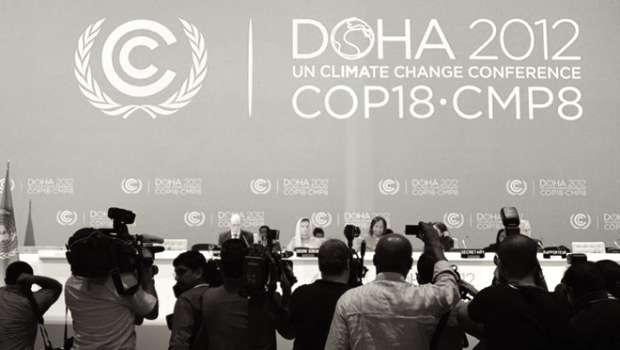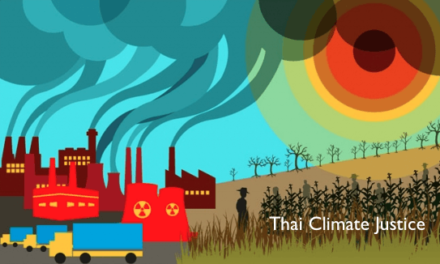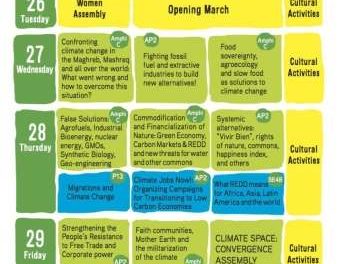By Walden Bello and Richard Javad Heydarian
Seldom has a global conference been so devoid of positive expectations than the coming United Nations Climate Conference that will take place in Doha, Qatar in late November and early December. People could be forgiven for thinking a joke was being played on them, given that the meeting is being held in Qatar, one of the world’s leading producers of oil—a key reason for the world’s climate woes.
But seldom has a meeting been as necessary for the future of the planet as the Doha meeting—also known as “Conference of Parties 18,” or COP 18. It is this massive gap between the planetary emergency and the frustrating realpolitik of climate negotiations that inflames global public opinion, especially against the two top carbon emitters, the United States and China.
The Climate Stalemate
The poor prospects for Doha stem, in large part, from the contradictory prescriptions that emerged from last year’s climate summit in Durban, South Africa (COP 17). The meeting approved two instruments. The first enjoins developed or “Annex 1” countries to commit to a second round of cuts under the Kyoto Protocol. The second, the so-called “Durban Platform for Action,” gives both Annex 1 and developing countries until 2015 to make commitments to make greenhouse reductions and until 2020 to begin implementing them.
The United States and most other developed countries will go to Doha with little sense of urgency or of responsibility. They prefer to be guided solely by the Durban Platform, which effectively gives them a seven-year “grace period” before taking action on their emissions. Since every year that action is postponed brings the world closer to climate disaster, the Durban Platform will surely rate as one of the most ill-conceived agreements in history, probably on par with the 1928 Kellogg-Briand Treaty, which “outlawed” war without requiring its signatories to take practical steps to achieve this goal.
For its part, the Group of 77 and China, the so-called developing country bloc, will arrive in Doha choosing to emphasize the first instrument, whereby the Annex 1 countries pledge to make a second round of commitments to reduce their carbon emissions under the Kyoto Protocol, which ends this year. There are equally serious problems with this approach. First, having brazenly behaved as a global outlaw by refusing to live up to a convention it helped draft, the United States is not about to make any new commitments under the Kyoto framework. Indeed, the United States’ failure to take its Kyoto commitments seriously has encouraged Canada, a state headed by climate skeptics, to declare its own independence from the Kyoto process.
The second problem is that the world has changed since Kyoto was drafted in 1992. The big emerging economies, also known as the “BRICS,” burst onto the world stage over the last two decades, with fossil-fuel based super-industrialization plans that have made them among the world’s biggest carbon emitters. India is now the world’s fourth-biggest carbon emitter. And China has become the world’s biggest emitter, responsible for a whopping 29 percent of global emissions in 2011, with its emissions rising by 9 percent from 2010.
China—whose per capita emission rate of 7.2 tons per person is now well within the 6-to-19 ton range of Annex 1 countries—comes to Doha determined to lodge all responsibility for making cuts with the Annex 1 countries while resisting making mandatory reduction commitments on the grounds that it is still a “developing country.” This, despite the fact that China is now the world’s second-biggest economy and is scheduled to drive past the United States in less than two decades.
But few among the Annex 1 countries are likely to buy Beijing’s line. Indeed, while not placing Beijing at the same level as a climate outlaw like the United States—and although they are hesitant to say so publicly—a number of developing countries see China as an opportunist hiding behind the skirts of the Group of 77 and are upset at its hardline stance against making mandatory commitments. It is clear that despite their seemingly antagonistic positions, the United States and China actually complement each other, since their intransigent stands prevent the achievement of a tough global agreement that would finally put a stop to their uncontrolled emissions.
With the two top carbon emitters coming to Doha determined to avoid any binding reductions, Doha may well prove an insignificant way station on the way to 2020, when countries will—theoretically—begin implementing their commitments. By which time, of course, it may well be too late.
The Deluge
The diplomatic maneuvering might have been tolerable were the effects of climate change not expected to be significant until the end of this century, as many scientists thought back when the Kyoto Protocol was being negotiated and ratified in the early 1990s. But this ineffectual North-South minuet becomes downright criminal in light of our collective realization that the full fury of climate change is lashing our planet much, much earlier than expected.
Superstorm Sandy, which smashed into New York City and New Jersey a few weeks ago, should have removed any remaining doubts in the United States that we are living in times when the new normal is abnormal, except among the most antediluvian Tea Party climate denialists.
Sandy came on the heels of other extreme weather events. A whopping 97 percent of the Greenland ice sheet melted in July, more than at any other time in 30 years of satellite observation. Indeed, this July was the hottest July the Untied States ever recorded. Also in the last year, a normally dry Beijing had the worst flooding since 1951. Long-delayed monsoon rains in India resulted in the second drought in four years. A weeklong “rainstorm with no name,” as many Filipinos termed it, plunged Manila into a watery disaster that is probably one of the worst in recent history. And last year, similar floods in Thailand resulted in what the World Bank estimated as the fourth costliest disaster in history. As for the small island states, the most vulnerable victims of global warming, the most recent data shows that the rate of sea level rise during the first decade of the 21st century far surpassed previous projections.
World Bank President Kim Yong Ding, not a person given to exaggeration, warns that with the current drift in global climate politics, the aim articulated during the Bali climate talks in 2007 of keeping the rise in global mean temperature to 2 degrees Celsius is now well nigh impossible, with a 3-to-3.5 degree increase now “probable.” The Bank’s recent comprehensive study of a world where the average temperature has risen by 4 degrees warns that “A 4°C world is likely to be one in which communities, cities and countries would experience severe disruptions, damage, and dislocation.” It concludes: “There is no certainty that adaptation to a 4°C world is possible.”
A Glimmer of Hope?
Yet, as in most other times when the world seems about to be plunged in darkness, there emerges a glimmer of hope that hints at the possibility of decisive action.
The truth of the matter is that no movement on the climate is possible without a deal between the United States and China. If dread at the probable catastrophic effects of thermonuclear war was what forced the antagonists to compromise during the Cold War—as they did famously during the Cuban Missile Crisis—so could fear of the unimaginable impacts of climate change serve as the catalyst for a compromise between Washington and Beijing. It is safe to say that, while the irresponsible chatter of climate skeptics fills the air in Washington, responsible policymakers there and in Beijing share this alarm of what is likely to come absent meaningful action.
Climate skeptics, political opportunists, corporate lobbyists, and shortsighted technocrats have been the main barrier to breaking the stalemate. Yet, as a number of observers have pointed out, certain new circumstances may embolden responsible leaders on both sides to reach out to each other.
In the United States, it is the combination of the pre-electoral vengeance of Superstorm Sandy and the fresh electoral mandate of President Barack Obama. Unmentionable during most of his campaign for reelection, global warming was on the president’s mind during his first post-election press conference, where he declared that he was a “firm believer that climate change is real and that it is impacted by human behavior,” and also that the United States had an “obligation to do something about it.” Of course, between recognizing climate change and making global commitments lies a wide gulf. Nevertheless, as other leaders have shown in similar circumstances, when political courage is summoned, the politically unrealistic can quickly become reality.
In China, there is currently underway a once-in-a-decade leadership transition. Pundits have characterized new leader Xi Jinping as unlikely to depart from the policies of the past, including on the climate. And yet, hungry for legitimacy in a country whose population has become sensitive to the environmental consequences of its high-speed-growth-at-any-price strategy, it is not impossible to imagine that the new leader might rise to the occasion.
Towards a Grand Compromise
A grand bargain between China and the United States to mutually and immediately undertake deep cuts in their emissions would serve as the breakthrough that could make other significant carbon emitters fall in line and enable a radical decrease in carbon emissions to keep global mean temperature from rising above 2 degrees Celsius by the end of the century. For the United States, this would mean committing to at least a 40-50-percent cut from its 1990 levels. For China, the corresponding reduction might be proportionally less, taking into consideration the principles of common but differentiated responsibility and historical responsibility for carbon emissions.
This U.S.-China deal could be the centerpiece of a broader, more comprehensive agreement that should include other Annex 1 countries agreeing to deep mandatory cuts in their greenhouse gas emissions—with cuts being in the range of at least 40-50 percent from 1990 levels by 2020. Likewise, other “Big Emerging Economies”—meaning, among others, India, Brazil, and South Africa—must also be subjected to mandatory cuts, though, as in China’s case, these would be at rates lower than the Annex 1 countries.
These binding commitments must be made and implemented right away, instead of waiting for 2015 to propose commitments and 2020 to begin implementing them as stipulated in the weak Durban Platform. Additionally, industrializing developing countries that are low or insignificant emitters of greenhouse gases must be encouraged, though not required, to make binding commitments as well, to underline to the Annex 1 countries and the Big Emerging Economies the urgency of arriving as soon as possible at a tough global agreement for the sake of all humanity.
Finally, Annex 1 countries must immediately transfer funds to the promised but as yet empty $100-billion Green Climate Fund to assist developing countries in taking action and adapting to climate change, their contributions being assessed according to their historical and current contributions to GHG emissions.
Beyond Kyoto and Durban
This approach goes beyond both the frameworks of the anachronistic Second Commitment Period of the Kyoto Protocol and the hapless Durban Platform. Of course, as with Kyoto and Durban, it would be best for such a comprehensive agreement to be adopted under the umbrella of the United Nations talks to give it legitimacy as well as mandatory sanctions. While the bargain might be too late for the Doha meeting, it could be the focus of intense negotiations soon after and be ready for approval during COP 19, the next climate gathering that will be held someplace in Eastern Europe in 2013.
Of course, a multilateral agreement with a grand compromise between China and the United States at its heart will not be enough by itself to reverse the negative climate trends. Only a comprehensive transformation from a global capitalist economy based on lusting after ever increasing profits via the incessant conversion of nature into dead commodities to a low-growth economy that promotes equity along with a harmonious relationship between society and the biosphere will decisively reverse the process. But the grand compromise is a necessary element in the broader solution.
Doha is likely to become another diplomatic tit-for-tat between the Group of 77 and China and the Annex 1 countries. But the patience of the world is wearing thin, especially when it comes to the United States and China, the globe’s leading carbon culprits. If the only thing that Doha can do is to expose the futility of the old strategies and the urgent necessity of exploring of new negotiating positions that can lead to a breakthrough before it is too late, then this diplomatic charade masquerading as a serious climate negotiation will have fulfilled its function.









